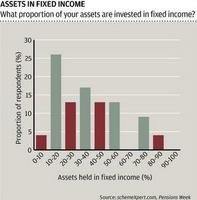In our second feature revealing the survey insights of 44 leading schemes and trustees, Owen Walker hears their two-year plan for fixed income investing
UK schemes plan to continue derisking their portfolios with fixed income assets over the next two years, despite recent market volatility, according to research carried out by schemeXpert.com and Pensions Week.
A survey of 44 scheme managers, investment directors and trustees – whose combined control of assets is in excess of £125bn – found the majority were fully committed to increasing their fixed income allocation in the short term to match their liabilities.
But it also found the schemes have changed their attitudes to more traditional forms of fixed income and started making allocations to non-core assets.
Government bond yields are currently at historically low levels as investors have turned away from volatile equities and sought safe havens.
This has led a number of the surveyed pension schemes to consider alternative forms of fixed income to provide a higher yield, while still keeping pace with their liabilities.
“We are looking at ways to improve our inflation and duration protection,” said the group pension director and investment committee member at an £800m scheme, which is currently 40% invested in fixed income.
“We’re considering making greater use of derivatives and forwards in this area, to allow more flexibility and quicker implementation of decisions.”
He added the scheme was also looking at asset classes such as infrastructure, forestry and agriculture to provide fixed income-like returns.
Two-year plans
Of the schemes that took part in the survey, 60% had less than 40% of their portfolios invested in fixed income assets. Just under a third had less than 20% committed to fixed income.
 The pensions manager of a scheme with 50% invested in fixed income said this had increased from 46% in 2008 and the aim was to increase the exposure to 65% as the funding level improved.
The pensions manager of a scheme with 50% invested in fixed income said this had increased from 46% in 2008 and the aim was to increase the exposure to 65% as the funding level improved.
There has been an increased trend in recent years for schemes with mature membership profiles to switch from return-seeking assets to liability-matching assets as they look to remove unnecessary risk from their portfolios.
The survey asked what changes schemes planned to make to their fixed income investments over the next two years.
The majority said they would continue to increase their weighting to fixed income and increase the match with their liabilities.
But others said, while they would ideally like to increase their fixed income allocations for the same reason, any movements would be based on favourable market conditions.
“If the yields rise considerably, we will consider switching into fixed income with duration matching, possibly at the 100% level depending on the scheme funding position at that time,” said a trustee of a £13.5m scheme.
But the investment director at one local authority scheme said she did not predict a significant change to the plan’s fixed income allocation unless its liability profile altered dramatically as a result of the government’s planned changes to the Local Government Pension Scheme.
Non-core asset classes
The survey revealed the most popular non-core fixed income asset class among respondents was emerging market debt (EMD), which a number of the schemes had begun investing in a few years ago.
The main reasons they gave for investing in EMD was the diversity it offered, and as an alternative income stream.
A couple of medium-sized schemes also made fairly large investments to high yield debt in early 2009 due to the “exceptional opportunity” it offered, but the fund manager of one public sector scheme said these bonds had since been sold.
There was also some interest in bond-based multi-strategy hedge funds, with the aim of reducing risk while achieving a diversified stream of returns.
The survey also showed a number of schemes had been nimble and reacted when opportunities arose.
“We’ve invested in leveraged loans,” said the chief executive of an £8bn scheme. “When the Icelandic banks went bust, they dumped lots of this stuff at silly prices so it was too good to miss.”
The investment director of a £4bn scheme added: “We made one small opportunistic investment when corporate bonds were cheap relative to other assets after the credit crisis.
“We also committed £100m to the M&G UK financing fund, which offers the opportunity to derive superior returns as a result of bank liquidity drying up for medium-sized companies.”
However, Thomas Hague, trustee director at the £1.5bn Pilkington Superannuation Scheme, said the fund had not invested in any non-core fixed income assets, but had invested in reinsurance.
“This has similar properties to fixed income, but should be less correlated to financial markets,” he added.






















